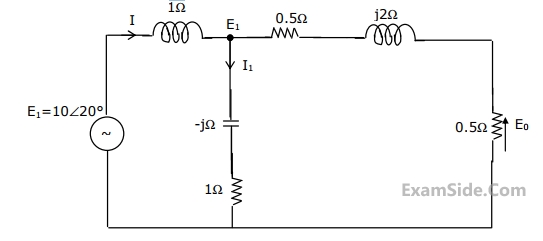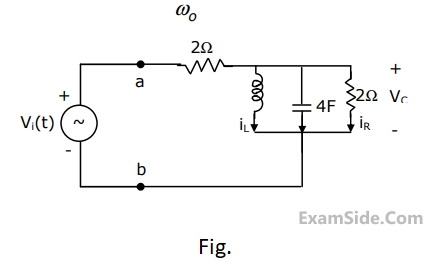1
GATE ECE 2001
Subjective
+5
-0
For the circuit shown in the figure, determine the phasors E2, E0, I and I1.


2
GATE ECE 2000
Subjective
+5
-0
For the circuit in Fig. Which is in steady state,


(a)Find the frequency $${\omega _0}$$ at which the magnitude of the impedance across terminals a, b reaches maximum.
(b) Find the impedance across a, b at the frequency $${\omega _0}$$.
(c) If $${v_i}\left( t \right) = V\,\,\sin \left( {{\omega _0}t} \right),$$ find $${i_L}\left( t \right),\,\,{i_c}\left( t \right),{i_R}\left( t \right).$$
3
GATE ECE 1999
Subjective
+5
-0
A coil with a quality factor $$(Q)$$ of $$10$$ is put in series with a capacitor $${C_1}$$ of $$10\,\,\mu F,$$ and the combination is found to draw maximum current when a sinusoidal voltage of frequency $$50$$ $$Hz$$ is applied. A second capacitor $${C_2}$$ is now in parallel with the circuit. What should be the capacitance of $${C_2}$$ for combined circuit to act purely as a resistance for a sinusoidal excitation at a frequency of $$100$$ $$Hz$$? Calculate the rms current drawn by the combined circuit at $$100$$ $$Hz$$ if the applied voltage is $$100V$$ (rms).
4
GATE ECE 1998
Subjective
+5
-0
Determine the frequency of resonance and the resonant impedance of the parallel circuit shown in figure. What happens when $$L = C{R^2}$$?


Questions Asked from Sinusoidal Steady State Response (Marks 5)
Number in Brackets after Paper Indicates No. of Questions
GATE ECE Subjects
Signals and Systems
Representation of Continuous Time Signal Fourier Series Fourier Transform Continuous Time Signal Laplace Transform Discrete Time Signal Fourier Series Fourier Transform Discrete Fourier Transform and Fast Fourier Transform Discrete Time Signal Z Transform Continuous Time Linear Invariant System Discrete Time Linear Time Invariant Systems Transmission of Signal Through Continuous Time LTI Systems Sampling Transmission of Signal Through Discrete Time Lti Systems Miscellaneous
Network Theory
Control Systems
Digital Circuits
General Aptitude
Electronic Devices and VLSI
Analog Circuits
Engineering Mathematics
Microprocessors
Communications
Electromagnetics